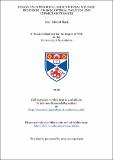Files in this item
Essays on categorical and universal welfare provision : design, optimal taxation and enforcement issues.
Item metadata
| dc.contributor.advisor | Ulph, David | |
| dc.contributor.author | Slack, Sean Edward | |
| dc.coverage.spatial | 321 p. | en_US |
| dc.date.accessioned | 2018-07-23T15:30:03Z | |
| dc.date.available | 2018-07-23T15:30:03Z | |
| dc.date.issued | 2016-06-24 | |
| dc.identifier.uri | https://hdl.handle.net/10023/15659 | |
| dc.description.abstract | Part I comprises three chapters (2-4) that analyse the optimal combination of a universal benefit (B≥0) and categorical benefit (C≥0) for an economy where individuals differ in both their ability to work and, if able to work, their productivity. C is ex-ante conditioned on applicants being unable to work, and ex-post conditioned on recipients not working. In Chapter 2 the benefit budget is fixed but the test awarding C makes Type I and Type II errors. Type I errors guarantee B>0 at the optimum to ensure all unable individuals have positive consumption. The analysis with Type II errors depends on the enforcement of the ex-post condition. Under No Enforcement C>0 at the optimum conditional on the awards test having some discriminatory power; whilst maximum welfare falls with both error propensities. Under Full Enforcement C>0 at the optimum always; and whilst maximum welfare falls with the Type I error propensity it may increase with the Type II error propensity. Chapters 3 and 4 generalise the analysis to a linear-income tax framework. In Chapter 3 categorical status is perfectly observable. Optimal linear and piecewise-linear tax expressions are written more generally to capture cases where it is suboptimal to finance categorical transfers to eliminate inequality in the average social marginal value of income. Chapter 4 then derives the optimal linear income tax for the case with classification errors and Full Enforcement. Both equity and efficiency considerations capture the incentives an increase in the tax rate generates for able individuals to apply for C. Part II (Chapter 5) focuses on the decisions of individuals to work when receiving C, given a risk of being detected and fined proportional to C. Under CARA preferences the risk premium associated with the variance in benefit income is convex-increasing in C, thus giving C a role in enforcement. | en_US |
| dc.language.iso | en | en_US |
| dc.publisher | University of St Andrews | |
| dc.subject | Categorical benefit | en_US |
| dc.subject | Classification errors | en_US |
| dc.subject | Conditionality | en_US |
| dc.subject | Enforcement | en_US |
| dc.subject | Inequality | en_US |
| dc.subject | Optimal taxation | en_US |
| dc.subject | Social welfare | en_US |
| dc.subject | Type I error | en_US |
| dc.subject | Type II error | en_US |
| dc.subject.lcc | HB99.3S62 | |
| dc.subject.lcsh | Welfare economics--Mathematical models | en |
| dc.subject.lcsh | Public welfare--Economic aspects | en |
| dc.subject.lcsh | Social security--Economic aspects | en |
| dc.subject.lcsh | Income maintenance programs--Economic aspects | en |
| dc.subject.lcsh | Taxation | en |
| dc.title | Essays on categorical and universal welfare provision : design, optimal taxation and enforcement issues. | en_US |
| dc.type | Thesis | en_US |
| dc.contributor.sponsor | AXA Research Fund | en_US |
| dc.type.qualificationlevel | Doctoral | en_US |
| dc.type.qualificationname | PhD Doctor of Philosophy | en_US |
| dc.publisher.institution | The University of St Andrews | en_US |
This item appears in the following Collection(s)
Items in the St Andrews Research Repository are protected by copyright, with all rights reserved, unless otherwise indicated.

